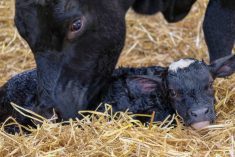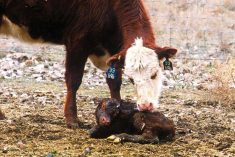The most critical aspect of promoting newborn calf health and reducing morbidity/mortality is to feed sufficient amounts of high-quality colostrum to each calf shortly after it is born. Once colostrum is fed, it becomes a matter of allowing its specialized antibodies to do their job. They do this by establishing temporary immune protection until the calf’s permanent system becomes activated at two months of age.
Each of these antibodies or immunoglobulins has a specific role in neonate calf immunity. For example, IgG can target pathogens in the tissue of the animal’s body, while IgM destroys bacteria that enter the bloodstream. Lastly, IgA attaches to the membranes of different tissues such as intestinal linings, which prevents E. coli from attaching themselves and causing disease. High colostrum Ig levels do not last long and in a few days and subsequent milkings return to a fraction of their immediate postpartum levels. Neither does the calf’s ability to absorb these immunoglobulins intact, because its ability to ingest and absorb whole immunoglobulins is short-lived. Their intestinal cells with a specialized pinocytic feature are all replaced by more non-specific conventional cells within 24 hours after the calf’s birth. Once the calf’s gut closes, no further large immunoglobulins can be absorbed.
Read Also

Harvest wraps up and fall work begins
At the Eppich famly ranch in western Saskatchewan, the fall harvest was successful with few breakdowns, cows and calves have been sorted and a new tractor has arrived
The on-the-farm practice to implement important passive immunity in newborn calves is to feed each calf 100 to 300 grams of immunoglobulin from colostrum within the first 12 hours of birth. Given that high-quality colostrum should contain at least 50 grams of IgG per litre, most dairy nutritionists instruct that four litres of colostrum be fed within the first two hours of life, followed by another two litres by six to 12 hours old. Consumption and absorption of immunoglobulins from colostrum following this protocol is considered successful if the calf’s IgG blood levels are over 10 g/litre to establish good passive immunity.
Ensure calves are protected
As a dairy nutritionist, I have witnessed many producers following this practice. In one example, a producer of a 350-dairy milking cow operation ensures that adequate colostrum is fed using an esophageal tube. He is very conscientious to ensure the baby calf does not aspirate any colostrum during the initial feeding (illustration) or during the second feeding a couple of hours later. He tells me that if a calf is on the small side, he reduces the amount of initial/first colostrum to about two to three litres.
In another case, I know a dairy producer that runs a 150-cow dairy and he prefers to leave the newborn calf with the cow for the first few hours of life. He watches the calf to ensure that it suckles. Afterwards, he removes the calf to a clean and straw-filled hutch and feeds the second colostrum with a two-litre bottle. Despite some concerns in the present literature about disease transfer from cow to calf, this producer assured me that he has never had such problems and it seems to only calm the mother for many hours after giving birth.
Despite both producers having different methods of feeding colostrum, they both have the means of testing colostrum of each cow with a refractometer and as a result ensure that each baby calf receives high-quality colostrum.
The first producer uses the black tubular refractometer ($30 to $50 per unit), in which he places a drop of colostrum on the glass side and reads a differentiation line between white and blue areas shown through the eyeglass.
The other producer has a digital refractometer ($450 per unit) in which he places a drop of colostrum in the centre eyepiece and receives a subsequent digital reading. It is generally accepted by both producers and research alike that at least 22 per cent on the Brix scale of both types of refractometers corresponds to at least 50 g/litre IgG, which is considered to be high-quality colostrum for baby calves.
These dairy farms are a testament that there is no real substitute for high-quality colostrum fed to newborn dairy calves. It provides immunoglobulins that can be consumed and directly absorbed across the intestinal wall only within a very short time after birth. As it happens, these antibodies give each dairy calf a seemingly magical chance at a healthy and productive life.
















